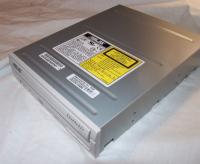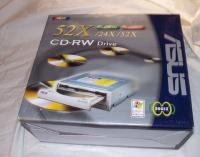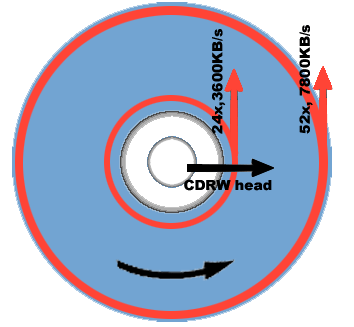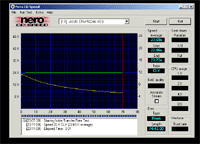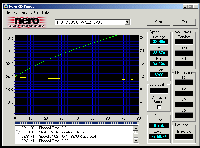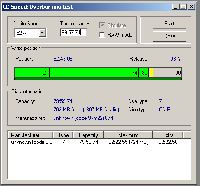
Original Link: https://www.anandtech.com/show/1055
ASUS CRW-5224A: CDR's Reach The End of the Line
by Kristopher Kubicki on January 13, 2003 7:26 PM EST- Posted in
- Storage
|
Quick Look |
|
|
ASUS CRW-5224A |
The Good |
|
+ 52X CDR burn speeds |
|
|
The Bad |
|
|
- CD Tray not pressure sensitive |
|
Introduction
When ASUS told us about their 48X CDRW drive a few months ago we figured CDRW drives could not get much faster. When we got a working 52X CDRW drive a few weeks ago we were a little surprised, but could the drive really be that much faster?
Remember, the 40X USB CDRW drive we looked at last month operated on a Zone CLV burn; the device only got up to 40X for less than a minute. Under the same logic, a ZCLV 52X CDRW would burn at 52X for an even shorter period of time.
That in mind, we have several extensive burn tests lined up for the drive. Even though there are several 52X CDRW drives on the market, the ASUS 5224A seems to be the most readily available drive.
Construction
The contents of a retail CRW-5224A kit include:
|
ASUS CRW-5224A
Drive
|
|
Visual appearance of the 5224A was consistent with that of the last four retail ASUS CDRW drives. The grooved faceplate looks exactly identical to the 4012A-U unit with the exception of different burn speeds written on the front. Other features on the front include headphone jack, volume control, 2 LEDs, a play button and an eject button. The LED on the right glows yellow when media is in the drive, while the LED on the left glows red when the drive is burning.
The drive itself is constructed with a heavy duty feel. The drive door gives the drive somewhat an appearance of a tank. Like the 4012A, the drive door hardly pressure sensitive at all. In order to get the drive to close, we had to push so hard we almost thought we broke it. After a few weeks we finally got used to using the button to eject and close the drive.
Since LiteOn manufactures the majority of the optical storage components in the 5224A, we noticed a large resemblance between the two drives. Unfortunately, the only issue we disliked in both drives was the buffer size. With the advent of FlextraLink, BurnProof, and others, drive manufactures are continually chopping away at the buffer. In the real world, burning to a disk with several intensive applications open, it does not take much effort to under run the buffer. FlextraLink coupled with an 8MB buffer would probably result in a much more versatile drive; capable of performing similar speeds in the real world just as easily as in a controlled environment.
|
ASUS CRW-5224A 52x/24x/52x CDRW Drive |
|
|
Interface |
IDE |
|
Write Speed |
52x (7800KB/s), 48x, 40x, 32x, 24x (CAV) |
|
Rewrite Speed |
24x, 16x, 12x, 10x, 8x 4x 2x (CLV) |
|
Read Speed |
52X Max (7800KB/s) (CAV) |
|
Supported Modes |
DAO / DAO-RAW 16 & 96 |
|
Access Time |
100ms |
|
Buffer |
2MB |
|
Gigabyte GA-7VRX |
|
AMD Athlon MP 2100+ |
|
2x128 DDR Corsair XMS 2400 |
|
ThermalTake Volcano 7 |
|
Seagate Cheetah 10000RPM |
|
Inno3D GeForce4 Ti 4200 |
|
Antec 420W Power Supply |
|
Windows 2000 SP3 Professional |
In order to test the drive, we will use the most versatile and widely used benchmarking suites for CDs. There are several intensive tests inside CDSpeed that we will be using. The first test is on a 24X rated ASUS CDRW bundled with the drive. The second test will be using the ASUS 52X CDR media bundled with the drive in order to test the maximum write speed of the drive. The last and probably most informative test is the maximum data read speeds from the drive. Remember, the drive is rated at 52X read and write.
We mentioned earlier that the drive burns at 52X at the fastest part of the burn. We can see from our burn tests that the drive peaks at 52X just at the end of the burn. Slightly interesting was that the drive actually reached speeds just under 52.5X, but our best guess is that 52.5X does not have the best marketing ring to it.
Even though the CRW-5224A
burns using CAV rather than ZCLV, we still achieved impressive results.
The final burn time on the ASUS media that was bundled with the drive was
As we noted with the 4012A-U, even with DDS-II, this unit was really loud. When attempting to spin up, the unit sounds more like a helicopter than a CDRW drive. Since we have both the 4012A-U and the 5224A in the lab, we actually determined the 5224A was a little louder. If you have gone out of your way to make your computer as quiet as possible, keep noise in mind when buying this unit.
Conclusions
There were several things that set the CRW-5224A apart from the 4012A-U drive we reviewed last month. However, there were also several things that seemed to not change at all. The first thing that was immediately apparent was the change in the write process. For whatever reason, ASUS has gone back to the CAV style of burning to squeeze that extra 12 seconds of burn time out of the drive. Other noted changes include Mt Rainier support, which we noticed to be absent in the 4012A-U drive.
However, most other things ASUS did not change with this drive. The appearance is still the same, the drive is still noisy, and the front panel still is not very pressure sensitive. These problems were all mostly overlookable though. The largest problem we had with the drive was the 2MB buffer. This is not overlookable. ASUS did a good job of hardly advertising the size of their buffer at all, so we had to dig pretty hard to find this information out. As we mentioned in the 4012A-U review, FlextraLink might go a long way to stop buffer underruns, but a larger buffer would only help this burner. Obviously, if the buffer underruns 3 times a burn, the final burn time is significantly longer. During our tests, we saw FlextraLink kick in much too often.
It is our opinion that ASUS keeps the buffer size small on their drives to keep the price of the unit down. At around 80USD, the drive is fairly aggressively priced. Similar LiteOn drives are retailing for around 70USD. Since there are few other 52X CDRW drives readily available, ASUS and LiteOn can pretty much call their price. Within a month or two, we will start seeing other manufacturers with 52X solutions, and prices will start to go down.
Media is going to hamper the usefulness of a 52X drive for a few more months to come. Until the price of good 52X media comes down a bit, most people will continue to use their 52X burner on 48X media.
Since this is the end of the line for CDRW drives, you can be pretty confident that getting a 52X drive now will not mark result in an obsolete unit several months down the line. From the manufacturers we talked to a COMDEX, most companies who usually offer CDRW solutions are slowly switching over product for 4X DVD-R/W and DVD+R/W drives instead. ASUS, whom are working on a 4X DVD-R/W burner based on the Pioneer drive, are no exception. Unless some manufacturer discovers a way to put multiple lasers on a CDRW drive, do not expect CDRW technology to change much in the future.

